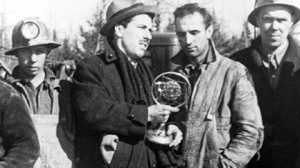
You’ve probably never heard of Luis Iribarren. Or Claudio Lagos. And you’ll likely never run across Dario Rojo in your lifetime. But, in fact, you do know them, all of them. They are three of the 33 men trapped in the Chilean mine since Aug. 5. For the record, you probably remember the very first words that Iribarren spoke to the world on Aug. 22.
“We are well,” he said through a communication line, “and we are hoping that you will rescue us.”
At about that moment, those at the mouth of a gold and copper mine near the town of Copiapo, Chile, received stunning news. Despite a cave-in of 700,000 tons of rock, all 33 of the men trapped nearly 700 metres underground had survived. Of course, we knew all this because the news journalists – now numbering over 1,000 – and all the remote, instant-news technology they bring – had raced to the mine to document the rescue effort.
But even if all those media people had not flocked there, something else would probably have sparked global attention. Human nature craves to know these stories.
It’s just a year ago that everybody, it seemed, witnessed the pursuit of a runaway hot-air balloon alleged to contain six-year-old Falcon Heene, the so-called “balloon boy.” So it was for the three astronauts aboard the damaged Apollo 13 capsule that eventually returned safely to Earth in 1970.
And remember baby Jessica, the infant rescued from that well near Midland, Texas? In October 1987 the18-month-old became wedged in the casing of an abandoned well 22 feet down. Rescuers pumped fresh air and heat to her and built rescue shafts to reach her. And 59 hours later, when they finally extricated her, bells rang and people cheered all over the world because “everybody’s baby” (the phrase became the title of a made-for-TV movie about the incident) had been saved.
While we fear the worst, we hope for the best. But whichever it is, we stop and watch… Or listen.
In the spring of 1936, Canadians tuning in to the brand new public radio network – the Canadian Radio Broadcasting Commission – learned that another gold mine – in Moose River, Nova Scotia – had entombed three miners. About 140 feet underground, the roof of the mine tumbled down on Herman Magill, Charles Scadding and Dr. David Robertson. Overnight, communities across the Maritimes and Ontario sent their most experienced miners to drill a rescue borehole through the crumbling rock; six days later the tunnel delivered a telephone cable to the buried men. A day after that the world heard reporter J. Frank Willis bringing the latest.
“Herman Magill is dead,” he announced on April 19, 1936. “Two others are still alive in the depths of Moose River Mine.”
Every half hour for 69 hours continuously, Willis delivered five-minute-long accounts across the CRBC (predecessor to CBC Radio) to 50 affiliated radio stations in Canada, 650 private stations across the U.S. and the BBC in Britain, on the status of the rescue. He painted word pictures of the “drab and desolate” countryside. He interviewed many of the “grim-lipped and determined” rescuers. He even dispelled rumours that the mine was about to cave in.
“These conflicting statements by certain interests in the United States are absolutely not true,” he announced in frustration. “We can spit into this pit and yet from thousands of miles away, people are contradicting what we have to say … There is no danger to the miners or to the buried men.”
On the 10th day of the drama, during his 99th report, Willis made history. He had delivered the most consecutive live broadcasts from one location in broadcast history. He had given birth to Canada’s first public radio network. He had spoken to the largest worldwide audience (up to that date) – more than 100 million listeners. And he had announced to them all these historic words:
“They have been saved. They are out of the mine. That is all.”
Perhaps that explains the similar attraction to the Chilean mine rescue. It’s human nature that listeners/viewers wish to be present at the conclusion of such things, to be able to say they were part of it, close to it, involved. People distant from the Moose River mine didn’t know Magill, Scadding or Robertson, but they felt as close as the rescuers to the rescue.
So it will be as the 33 Chilean miners emerge. Only this time, media and the thousand reporters will make Lagos (who proposed by letter to his girlfriend while he was underground), Rojo (whose father was once trapped in a mine) and Iribarren (who first said, “we are well” to the world) celebrities and heroes.
And we’ll always remember where we were when it happened.